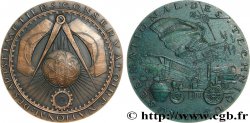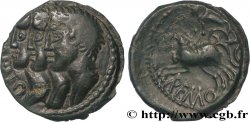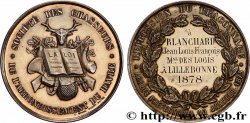fme_1053450 - V REPUBLIC Médaille, Bicentenaire de la Révolution, L’être suprême
40.00 €
Количество
Добавить в корзину

Тип Médaille, Bicentenaire de la Révolution, L’être suprême
Дата: 1987
Монетный двор / Город: Monnaie de Paris
Металл: bronze
Диаметр: 77 mm
Ориентация осей монеты: 12 h.
Гравер MAUVIEL Jacki (1935-)
Вес: 248,08 g.
Век: lisse + corne BR + 1987
Пуансон: corne BR
Комментарии о состоянии
Patine hétérogène. Présence d’un minime coup sur la tranche. L’avers présente de légers points d’oxydation
Лицевая сторона
Аверс: легенда: L’ÊTRE SUPRÊME.
Аверс: описание: Foule au pied d’une coline sur laquelle se trouve un arbre entre le soleil et un oeil omniscient .
Обратная сторона
Реверс: легенда: BICENTENAIRE / DE LA / RÉVOLUTION / FRANÇAISE.
Реверс: Описание: Légende en 4 lignes horizontales.
Комментарий
Médaille conservée dans un écrin en carton bordeaux de la monnaie de Paris.
Le culte de la Raison des Hébertistes athées (automne 1793 – printemps 1794) puis le culte de l'Être suprême des Montagnards déistes (printemps – été 1794) sont, en France, un ensemble d'événements et de fêtes civiques et religieuses. Le théophilanthropisme est une émanation du culte de l'Être suprême apparu en 1796 (26 nivôse an V) et interdit en 1803.
Il est explicitement fait référence à l'Être suprême dans le préambule de la Déclaration des droits de l'homme et du citoyen de 1789, qui est un pilier du système juridique, politique et social français :
« L'Assemblée Nationale reconnaît et déclare, en présence et sous les auspices de l'Être suprême, les droits suivants de l'Homme et du Citoyen ».
Medal preserved in a burgundy cardboard case from the Paris Mint. The cult of Reason of the atheist Hébertists (autumn 1793 – spring 1794) and then the cult of the Supreme Being of the deist Montagnards (spring – summer 1794) are, in France, a set of civic and religious events and festivals. Theophilanthropism is an emanation of the cult of the Supreme Being which appeared in 1796 (26 Nivôse Year V) and was banned in 1803. Explicit reference is made to the Supreme Being in the preamble to the Declaration of the Rights of Man and of the Citizen of 1789, which is a pillar of the French legal, political and social system: \\\"The National Assembly recognizes and declares, in the presence and under the auspices of the Supreme Being, the following rights of Man and of the Citizen\\\"
Le culte de la Raison des Hébertistes athées (automne 1793 – printemps 1794) puis le culte de l'Être suprême des Montagnards déistes (printemps – été 1794) sont, en France, un ensemble d'événements et de fêtes civiques et religieuses. Le théophilanthropisme est une émanation du culte de l'Être suprême apparu en 1796 (26 nivôse an V) et interdit en 1803.
Il est explicitement fait référence à l'Être suprême dans le préambule de la Déclaration des droits de l'homme et du citoyen de 1789, qui est un pilier du système juridique, politique et social français :
« L'Assemblée Nationale reconnaît et déclare, en présence et sous les auspices de l'Être suprême, les droits suivants de l'Homme et du Citoyen ».
Medal preserved in a burgundy cardboard case from the Paris Mint. The cult of Reason of the atheist Hébertists (autumn 1793 – spring 1794) and then the cult of the Supreme Being of the deist Montagnards (spring – summer 1794) are, in France, a set of civic and religious events and festivals. Theophilanthropism is an emanation of the cult of the Supreme Being which appeared in 1796 (26 Nivôse Year V) and was banned in 1803. Explicit reference is made to the Supreme Being in the preamble to the Declaration of the Rights of Man and of the Citizen of 1789, which is a pillar of the French legal, political and social system: \\\"The National Assembly recognizes and declares, in the presence and under the auspices of the Supreme Being, the following rights of Man and of the Citizen\\\"








 Cообщить об ошибке
Cообщить об ошибке Распечатать страницу
Распечатать страницу Отправить мой выбор
Отправить мой выбор Задать вопрос
Задать вопрос Consign / sell
Consign / sell
 Информация
Информация















